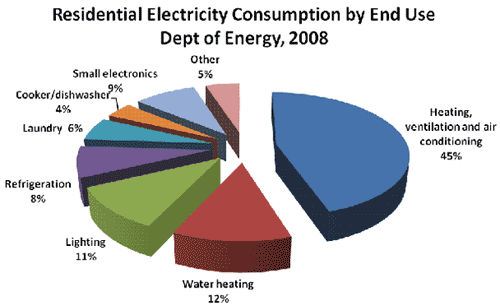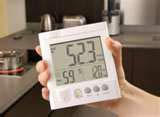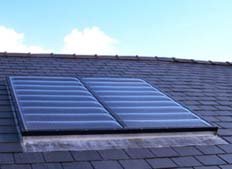With this in mind, to my husband’s frequent irritation, I constantly try to reduce the electricity demands of our large and complicated household. His irritation is generated by my failed experiments (he never notices the successful ones).
For example, I shipped twenty LED light bulbs from China to replace the 50 W halogen bulbs in our kitchen – the website didn’t say it was in China and I didn’t think to ask. Not only did the shipping massively increase the carbon footprint of the light bulbs, but it turns out that when they say a 4 W LED is equivalent to a 50 W halogen, they are wrong! After about two weeks of stumbling around the kitchen in the semi-dark, my husband finally flipped and went out to buy a whole new set of halogens. Now the carbon footprint of the kitchen lighting is equivalent to about fifteen 50 W halogens burning most of the day, plus the cost of manufacturing, and shipping twenty failed LED light bulbs.
The point of this tale of woe is that going green in Bermuda is easier said than done. According to the Department of Energy, most of our electricity goes on air conditioning, with water heating also significant.

Like many environmentally friendly (or just wallet conscious) householders, I would like to know how our energy usage compares with that of other Bermuda households. This information is often provided by a “Home Energy Rating Scale” or HERS. A home energy rating can be used to gauge the current energy efficiency of a home or estimate the efficiency of a home that is being constructed or improved. Energy assessments take into account different climatic conditions and are benchmarked according to average household energy consumption particular to a given climatic region.
Many countries have developed a tool for homeowners. A well-regarded and widely used system is the US Environmental Protection Agency’s Energy Star. This was originally developed and is most widely known for comparing the energy efficiency of home appliances. In the US it has also been extended to homes.
 The Energy Star rater reviews the home to identify its energy characteristics, such as insulation levels, window efficiency, wall-to-window ratios, heating and cooling system efficiency, solar orientation of the home, and the water heating system. Performance testing, such as a blower door test for air leakage and duct leakage, is usually part of the rating. Energy Star homes are at least 15% more energy efficient than older homes and include additional energy-saving features that typically make them 20–30% more efficient than standard homes. Versions of the Energy Star system are used not just to provide information and motivation to consumers, but also for verification of building energy performance for such programs as federal tax incentives and ‘green’ mortgages.
The Energy Star rater reviews the home to identify its energy characteristics, such as insulation levels, window efficiency, wall-to-window ratios, heating and cooling system efficiency, solar orientation of the home, and the water heating system. Performance testing, such as a blower door test for air leakage and duct leakage, is usually part of the rating. Energy Star homes are at least 15% more energy efficient than older homes and include additional energy-saving features that typically make them 20–30% more efficient than standard homes. Versions of the Energy Star system are used not just to provide information and motivation to consumers, but also for verification of building energy performance for such programs as federal tax incentives and ‘green’ mortgages.
In Australia the Green Star program gives a rating of up to six stars for residences. This is a comprehensive assessment including an assessment of the environmental impact of a project’s site selection, design, construction and maintenance. The nine categories assessed include: management, indoor environment quality, energy, transport, water, materials, land use and ecology, emissions, innovation. All new homes must comply with the five-star standard. This means it is compulsory for new houses to have a five-star energy rating for the building fabric, a rainwater tank for toilet flushing, a solar hot water system, and water efficient shower heads and taps.
 Surely a system like this would make sense for Bermuda, too, but Bermuda is another world. Energy considerations are not included in planning applications, and none of the existing energy rating schemes work directly for us, even if we match climatic conditions. Our building materials, fresh-water resources, costly electricity (both in terms of carbon footprint and dollars), and lack of renewable energy resources mean that local energy-use patterns are unique.
Surely a system like this would make sense for Bermuda, too, but Bermuda is another world. Energy considerations are not included in planning applications, and none of the existing energy rating schemes work directly for us, even if we match climatic conditions. Our building materials, fresh-water resources, costly electricity (both in terms of carbon footprint and dollars), and lack of renewable energy resources mean that local energy-use patterns are unique.
For these reasons, Greenrock has started a project with Coldwell Banker to provide energy comparisons for Bermuda’s homes.
Until this Bermuda HERS in place, there are things that we all can do to reduce our domestic energy consumption. As shown in the pie chart above, heating and cooling use almost half our electricity, so anything that improves insulation helps. For example, replacing old windows with double glazing and low-emission coatings, reducing draughts and making sure doors fit well.
 The next biggest category is water heating. Solar thermal hot water panels can repay your investment in just a few years, and using timers on water heaters repays much faster. New technologies such as compact fluorescent light bulbs (CFLs) and instant hot water heaters will also help, as do old technologies such as “solar clothes dryers”, also known as washing lines. Of the big chunk of the electricity bill that goes on laundry, 90% is used by the clothes dryer.
The next biggest category is water heating. Solar thermal hot water panels can repay your investment in just a few years, and using timers on water heaters repays much faster. New technologies such as compact fluorescent light bulbs (CFLs) and instant hot water heaters will also help, as do old technologies such as “solar clothes dryers”, also known as washing lines. Of the big chunk of the electricity bill that goes on laundry, 90% is used by the clothes dryer.
However, wouldn’t it be great to get rid of most of that 6.5 metric tons of CO2 per home by using renewable resources like solar panels and wind turbines ? Wind turbines look cool, Bermuda’s average wind speed is about 12-15 knots day in day out, and once you have bought it, the electricity is free – no carbon, no fossil fuels, no shipping from China, no maintenance. Payback time is generally three to five years. Now all I have to do is convince my husband …

